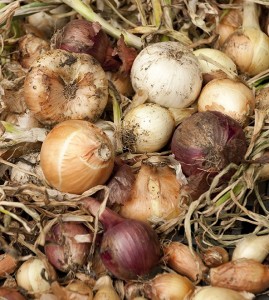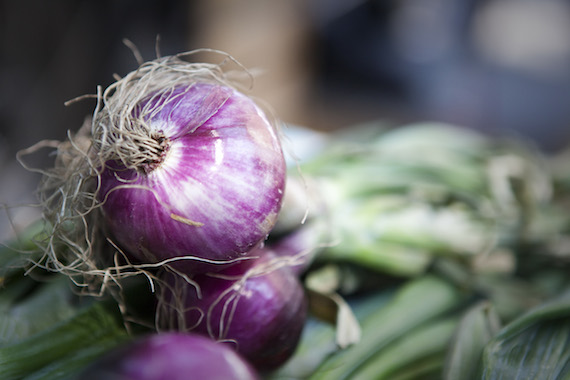Mighty Onions
Posted in Gardening Tips on April 1 2014, by Sonia Uyterhoeven
Sonia Uyterhoeven is the NYBG’s Gardener for Public Education.
 I can be very sentimental when it comes to gardening, and the subject of today’s topic always brings a tear to my eyes: onions. My favorite onions are bunching onions (spring or green onions), though they are not the culprits that make me cry. Spring onions are an incredibly versatile delight that can be tossed into a salad or sauce at the last minute. Instead, it’s their pungent cousins that get me, so let’s talk about them.
I can be very sentimental when it comes to gardening, and the subject of today’s topic always brings a tear to my eyes: onions. My favorite onions are bunching onions (spring or green onions), though they are not the culprits that make me cry. Spring onions are an incredibly versatile delight that can be tossed into a salad or sauce at the last minute. Instead, it’s their pungent cousins that get me, so let’s talk about them.
You will notice that onions are listed as three separate growing types: short-day, intermediate, and long-day varieties. Onions are sensitive not only to temperatures but to the amount of daylight, as well. Short-day onions will start to form their bulbs with 11-12 hours of daylight; intermediate types need between 12 and 18, and long-day onions only form their bulbs after receiving 14 hours or more of sunlight.
Northerners grow long-day onions that are planted in the spring, southerners plant short-day onions grown in the winter, and intermediate types are generally planted in early spring and harvested in summer.
Southerners host the sweetest varieties of onions, which they plant around October and harvest in April. ‘Vidalia’ and ‘Yellow Granex’ are two of the most popular short-day varieties. Though if you try to grow these in our neck of the woods you will find that they bulb up too early and don’t reach a good size. These onions are also full of water, meaning they do not store well like other varieties. Keep them in your refrigerator and use them up quickly.
The intermediate-day onions—often referred to as day-neutral, since they handle a wide range of growing conditions—are better in terms of storage. They generally have spicy sweet flavors. ‘Superstar’, ‘Candy’, ‘Early Yellow Globe’, and ‘Red Candy Apple’ are four well-known varieties and the first two are All-American Selection winners.
Long-day onions are known for their good storage and pungent flavor. Some popular varieties are ‘Copra’, ‘New York Early’, ‘Yellow Globe Danvers’, and ‘Red Wing’. ‘Cabernet’ is a medium-sized storage onion that you can harvest earlier than most long-day varieties.
Many heirloom onions are worth trying as well. ‘Ailsa Craig’ is an English heirloom with a sweet flavor and good storage (intermediate). ‘Long Red Florence’ with its bottle-shaped bulb is so mild and sweet that it is best eaten raw, while ‘Yellow Borrettana’ (a.k.a. Cipollini) is the perfect complement to a kabob.

Next week, we will discuss planting techniques. For all those blubbering chefs like myself, here are some tips on keeping your eyes dry when slicing onions. No promises!
1. Use a sharp knife—enzymes that make you cry are released when you crush the cells in the onion. A sharper knife means cleaner cuts.
2. Chill your onion for 10-15 minutes in the freezer before you slice it. It reduces the amount of enzymes released into the air. Chefs recommend this trick.
3. Soak the onion in water. This helps to denature the enzyme.
4. Light a candle and place it near the cutting board—the onion vapors are drawn to the flame.
5. Whistle or chew gum while you slice. Whistling keeps the air flow away from your face and presumably gum chewing does the same. Who knew?
6. Breathe through your mouth. Your olfactory nerves are close to your tear ducts and when you breathe through your mouth less of the onion’s gases will get to your olfactory nerves.
7. Just accept it as part of the complete onion experience!

